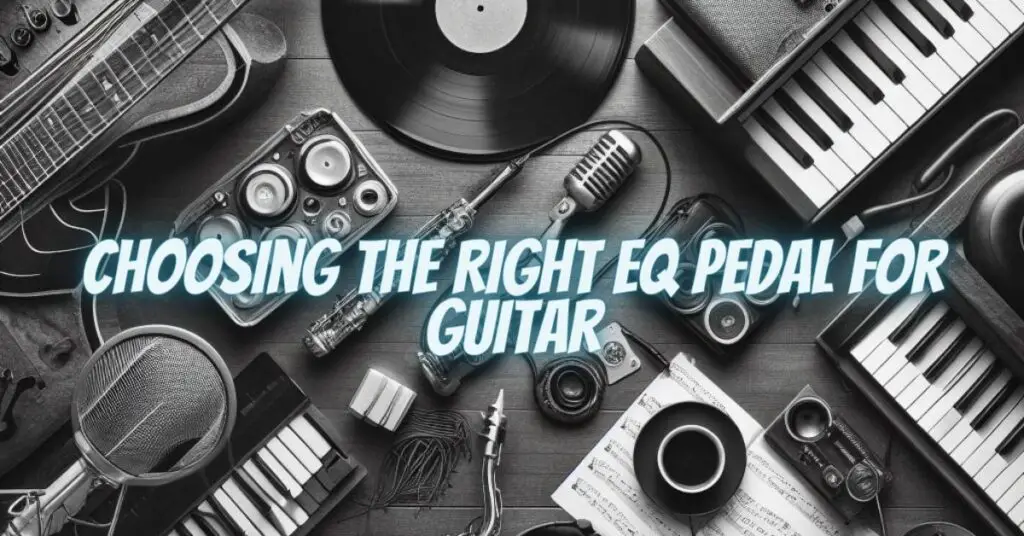The quest for the perfect guitar tone often involves the use of equalization pedals to shape and fine-tune the sound. Guitarists face a common dilemma: choosing between digital and analog EQ pedals. This article delves into the digital vs. analog EQ pedal debate, weighing the pros and cons of each to help you make an informed decision based on your specific needs and tonal preferences.
Digital EQ Pedals: Precision and Versatility
Digital EQ pedals use advanced digital signal processing to modify your guitar’s tone. Here are some of the advantages they offer:
- Precision: Digital EQ pedals provide precise control over the frequency spectrum. You can make pinpoint adjustments to your tone, making them ideal for situations where surgical precision is needed.
- Versatility: Digital EQs offer a variety of filter types, including graphic EQs, parametric EQs, and shelving filters. This versatility allows you to tailor your sound to different musical genres and playing styles.
- Recall and Presets: Many digital EQ pedals come with preset capabilities, making it easy to switch between different tonal settings on the fly. This feature is especially useful for live performances, where you need to adapt to changing songs quickly.
- Low Noise: Digital EQs typically have low noise levels, ensuring a quiet signal path. This is advantageous when working in a studio setting or using sensitive recording equipment.
- Linear Phase: Some digital EQs offer linear-phase processing, which maintains phase coherence across all frequencies. This ensures that your sound remains transparent and natural.
Analog EQ Pedals: Warmth and Character
Analog EQ pedals rely on analog circuitry to modify your guitar’s tone, providing a unique set of advantages:
- Warmth and Character: Analog EQs are revered for adding warmth and character to your tone. They often impart a particular “color” that many guitarists find appealing, making them a go-to choice for achieving a vintage, organic sound.
- Tactile Control: Analog EQ pedals typically feature physical knobs and sliders, offering a hands-on approach to tone shaping. This direct interaction with your sound can be more intuitive and immediate.
- Headroom and Transparency: Analog EQs have high headroom, meaning they can handle high input levels without distortion. This quality is crucial for making subtle, transparent tonal adjustments while maintaining your guitar’s dynamic range.
- Simplicity of Integration: Analog EQ pedals are straightforward to integrate into your pedalboard, offering simplicity and ease of use.
Finding the Right Fit
When deciding between digital and analog EQ pedals for your guitar, consider the following factors:
- Tonality: What kind of sound are you trying to achieve? If you’re after a pristine, detailed sound with precise control, digital EQ is a good choice. For a vintage, warm, and character-rich tone, analog EQ may be your preference.
- Application: Are you using the EQ pedal primarily for studio recording, live performances, or practice? Digital EQs offer recall and preset features, making them versatile for live settings. Analog EQs provide a more tactile experience and are often favored for recording.
- Signal Chain: Consider the complexity of your signal chain. If you have a more elaborate setup with multiple effects pedals, digital EQ can offer enhanced signal routing options and flexibility. Analog EQs may be a better fit for simpler setups.
- Budget: Analog EQ pedals can sometimes be more expensive due to their vintage and boutique appeal. Digital EQ pedals often provide cost-effective options without compromising on sound quality.
The choice between digital and analog EQ pedals for your guitar ultimately depends on your tonal goals and how you intend to use the pedal. Both digital and analog EQs offer distinct advantages, from precision and versatility to warmth and character. By understanding the nuances of each and considering your specific needs, you can select the right EQ pedal to shape your guitar tone according to your vision and musical style.


